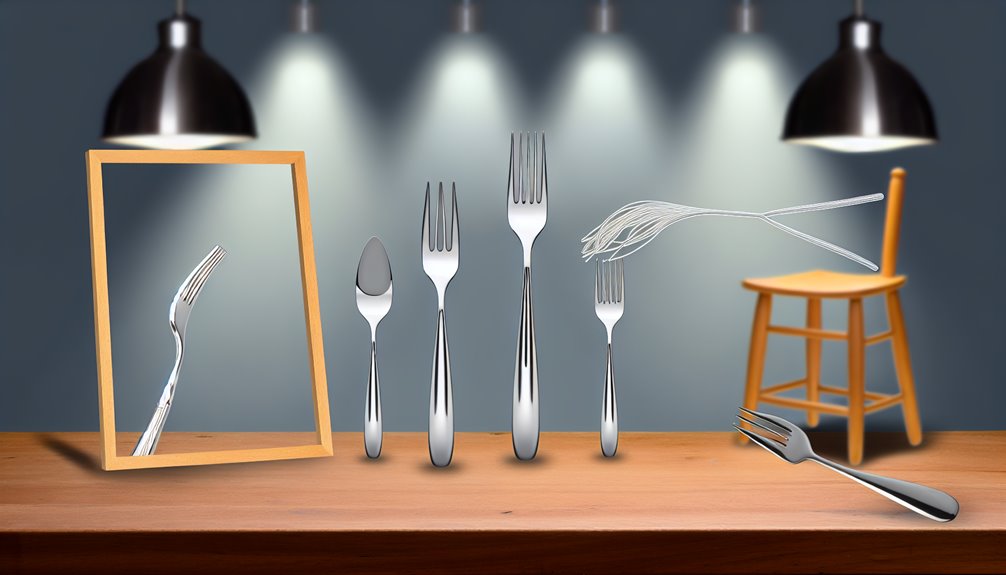To make mealtime a breeze, you’ll want to have five essential types of kitchen forks. A dinner fork is perfect for main courses, while a salad fork helps you enjoy greens easily. When serving, a sturdy serving fork transfers dishes without mess. For dessert, a delicate dessert fork enhances your sweet treats experience. Finally, a carving fork is essential for slicing meat. Each one has its purpose, and there’s more to discover about how they elevate your dining.
Key Takeaways
- Dinner Fork: Essential for main courses, its sturdy design pairs well with knives for cutting hearty meals.
- Salad Fork: Smaller and wider, it expertly handles leafy greens, making salads easier and more enjoyable to eat.
- Serving Fork: Ideal for transferring food from dishes to plates, it helps maintain neatness during serving.
- Dessert Fork: Delicate and smaller, it’s perfect for enjoying sweet treats, adding elegance to dessert presentations.
- Carving Fork: Holds meat securely while slicing, enhancing the ease and precision of serving large cuts of meat.
Dinner Fork
The dinner fork is a staple in any dining set, designed for main courses and hearty meals. Typically, you’re using it with a knife and perhaps a spoon, making it essential for a well-rounded dining experience.
When it comes to dinner fork etiquette, remember to hold it in your left hand while cutting food with your right. This keeps your dining experience smooth and polished.
As for dinner fork materials, you’ll find them made from stainless steel, silver, or even plastic for casual settings. Each material offers its advantages, from durability to aesthetic appeal.
Choosing the right dinner fork can elevate your meal, ensuring you enjoy every bite with ease and grace.
Salad Fork
When you’re enjoying a salad, the salad fork plays a key role in your dining experience. This smaller fork, typically with a shorter handle and wider tines, is designed to help you easily scoop up leafy greens and toppings.
There are various salad fork types, including those made of stainless steel, plastic, or even bamboo, catering to different dining occasions.
Using a salad fork not only enhances your ability to enjoy fresh ingredients but also adds a touch of elegance to your table setting. You can use it for simple side salads or more elaborate dishes with delicate components.
Serving Fork
A serving fork is an essential tool for any dining table, designed to help you effortlessly transfer food from serving dishes to your plate. Its long tines and sturdy design make it perfect for picking up everything from roasted vegetables to pasta.
You’ll find that a serving fork reduces mess, allowing you to serve food neatly and efficiently.
Typically made from materials like stainless steel, plastic, or wood, each option offers different benefits regarding durability and aesthetics. Stainless steel forks are durable and easy to clean, while wooden ones add a rustic charm.
Understanding serving fork uses will enhance your dining experience, ensuring you can share meals with family and friends without hassle.
Dessert Fork
After serving up your main course with a reliable serving fork, it’s time to turn your attention to dessert.
A dessert fork is specifically designed for indulging in sweet treats, providing a smaller and more delicate option than standard forks. You’ll find various dessert fork types, including classic, vintage, and modern designs, each adding a unique flair to your dining experience.
When it comes to dessert fork materials, you can choose from stainless steel, silver, or even plastic for casual gatherings. Each material has its own charm and functionality, making it easy to find the perfect match for your dessert spread.
Carving Fork
The carving fork is an essential tool for any home cook or chef, designed specifically to make slicing and serving large cuts of meat a breeze.
With its long, sturdy tines, it holds the meat securely in place, allowing you to use proper carving techniques without the fear of slipping.
You’ll find carving forks made from various fork materials, such as stainless steel for durability or high-carbon steel for a sharper edge.
When choosing a carving fork, consider the balance and weight that feels comfortable in your hand.
This tool not only elevates your serving game but also enhances your overall cooking experience, making it easier to impress your guests with perfectly sliced portions.
Frequently Asked Questions
What Materials Are Kitchen Forks Typically Made From?
Imagine a sturdy ship steering through the sea; kitchen forks, like those ships, are often made from stainless steel for durability or lightweight plastic for casual meals. Each material serves its purpose in your culinary adventures.
How Do I Properly Clean and Maintain My Kitchen Forks?
To properly clean and maintain your kitchen forks, use gentle cleaning techniques like warm soapy water and a soft cloth. Regularly inspect for rust and follow maintenance tips to guarantee they stay in top shape.
Can I Use a Fork for Cooking as Well?
Did you know 70% of home cooks use forks for more than just eating? You can absolutely use a fork as a versatile cooking utensil, whether you’re mixing, flipping, or tenderizing ingredients in your kitchen!
Are There Specific Sizes for Forks, and Why Do They Matter?
Yes, fork sizes and shapes matter because they influence how you handle food. Smaller forks are great for delicate dishes, while larger ones suit hearty meals. Choosing the right fork enhances your dining experience.
What Is the History of Kitchen Forks in Culinary Use?
You’ll find that kitchen forks evolved from ancient utensils, gaining popularity in the 16th century. As dining etiquette developed, they became essential for proper table manners, transforming how people enjoyed meals across cultures.



